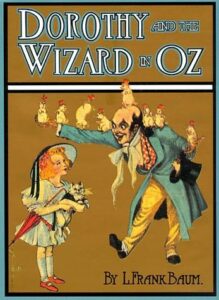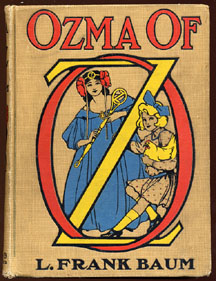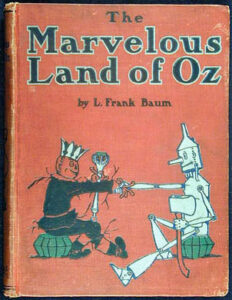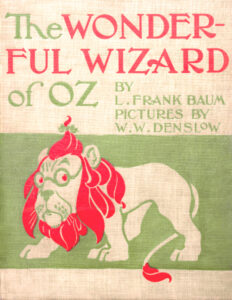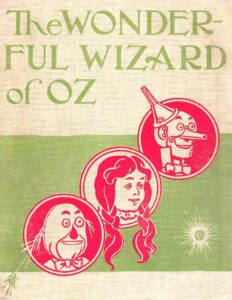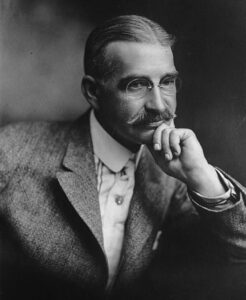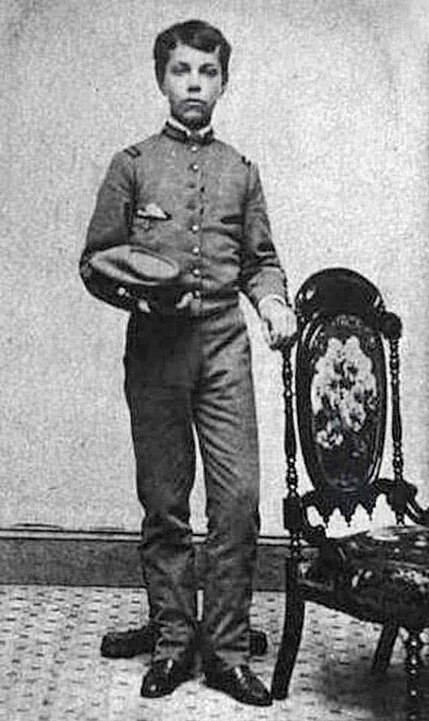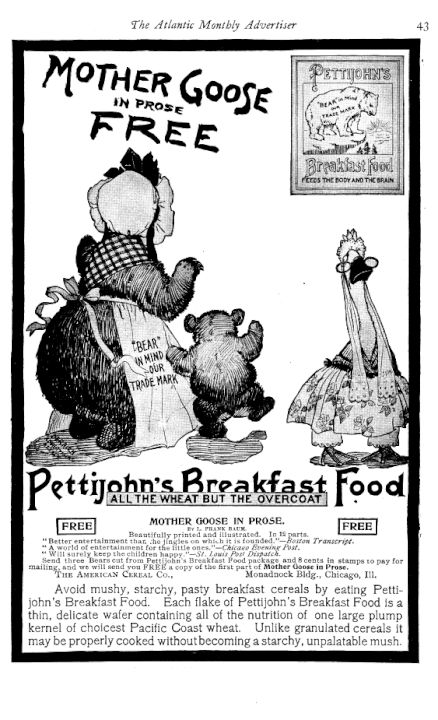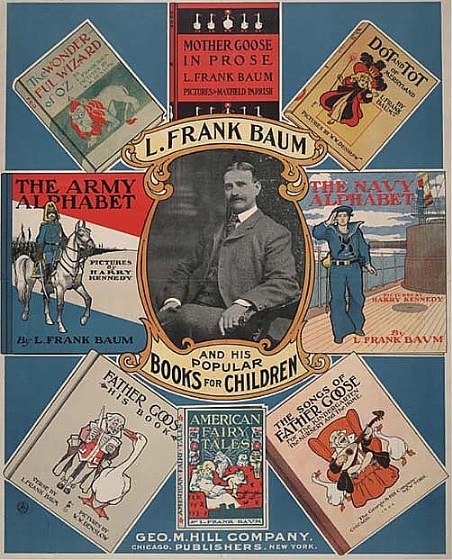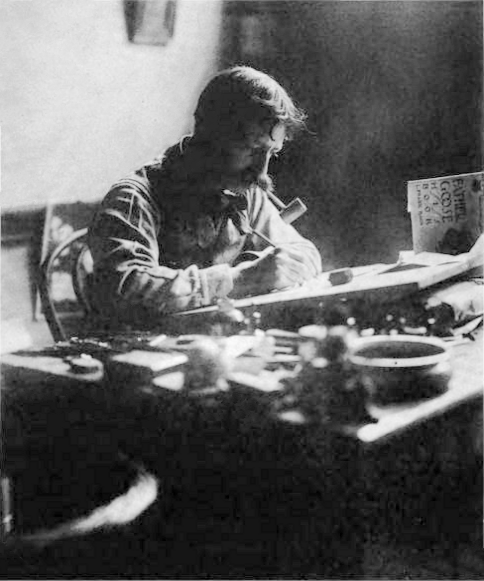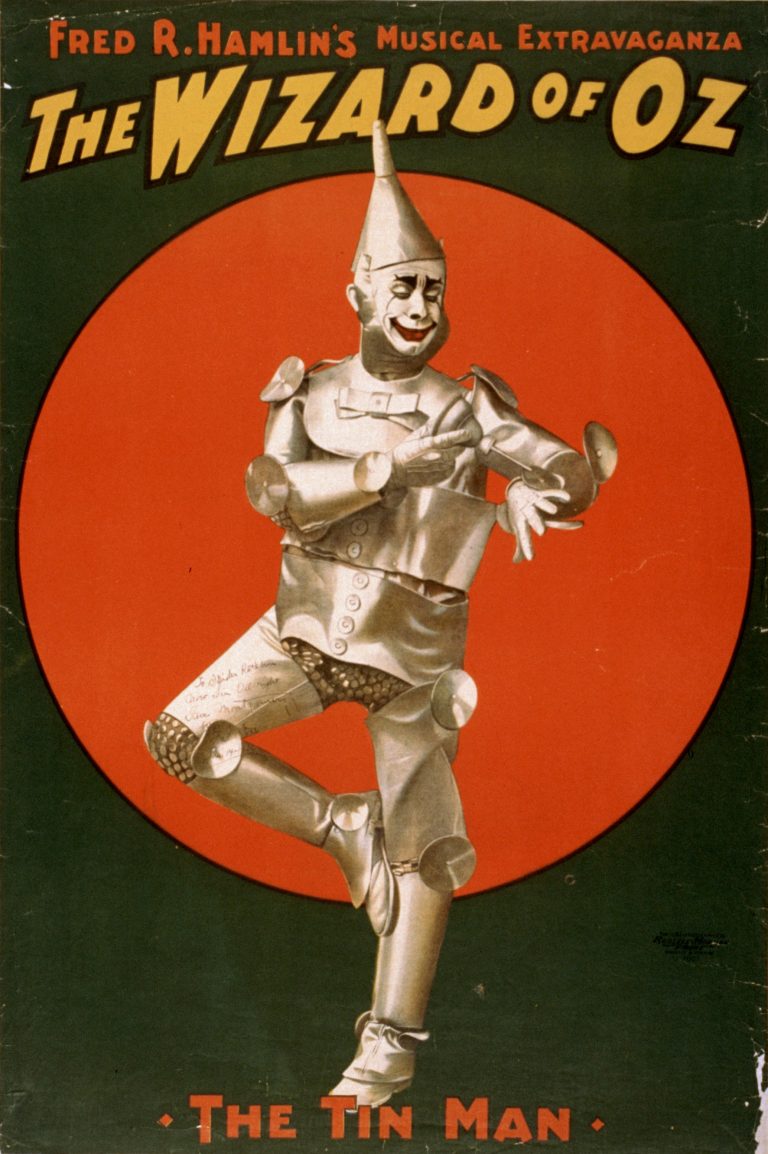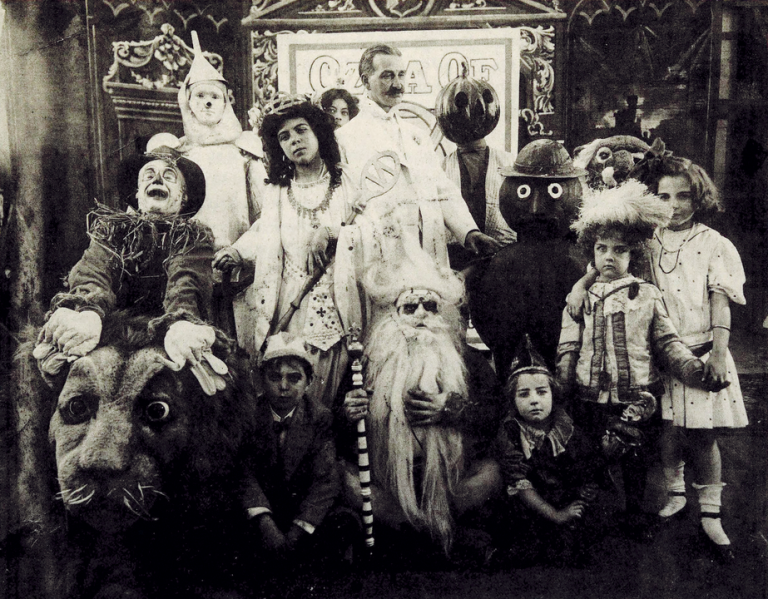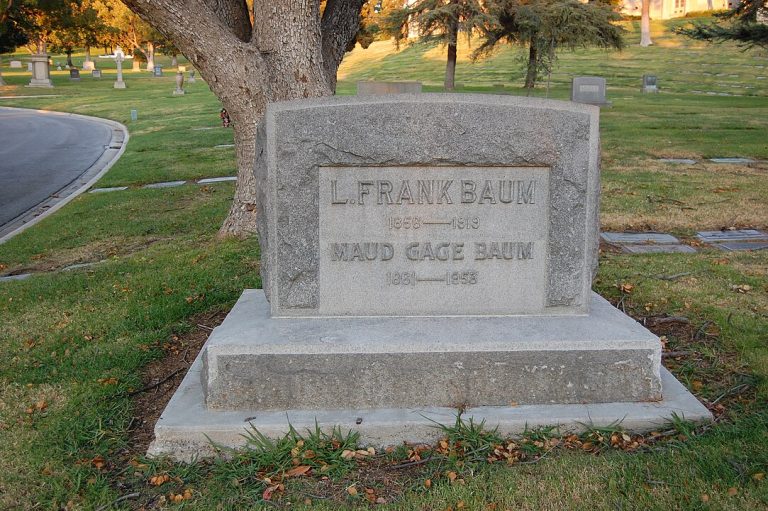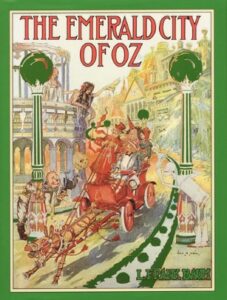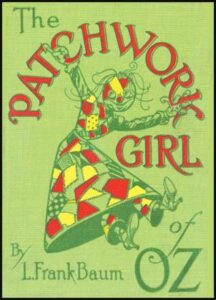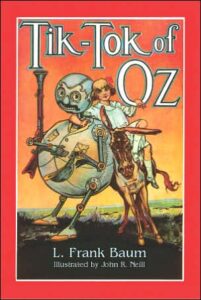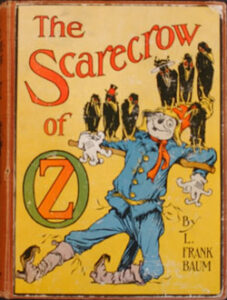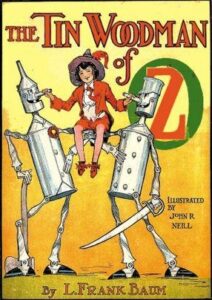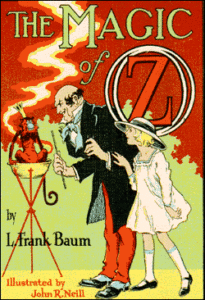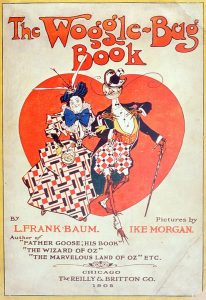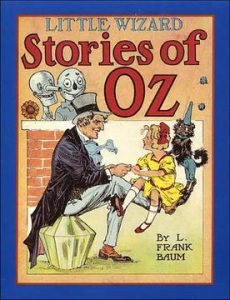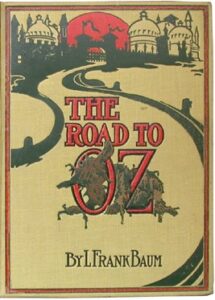
You can download this book and the thirteen other fantasy books in the Oz series by L. Frank Baum via Project Gutenberg by clicking here.
About The Road To Oz
The Road to Oz is the fifth of L. Frank Baum’s Land of Oz books. It was originally published on July 10, 1909 and documents the adventures of Dorothy Gale’s fourth visit to the Land of Oz.
The book was dedicated to Joslyn Stanton Baum, the author’s first grandson, the child of Baum’s eldest son Frank Joslyn Baum.
Publication
The sales figures of Baum’s other fantasy novels always lagged behind his Oz novels; it has therefore been theorized that the guest appearances of his non-Oz characters in The Road to Oz were a marketing ploy to raise interest in those other titles.
This is the only Oz book to be printed on coloured pages instead of with coloured pictures. The coloured pages represent the signature colours of the various countries of Oz that Dorothy and her companions travel through on their way to the Emerald City.
The Tin Woodman’s garden features images of Dorothy and Toto, representing them as they first arrived in Oz. The illustrator, John R. Neill, apparently takes this description literally, by causing the statues to resemble the illustrations made by his predecessor, W.W. Denslow. This is in contrast to the “real” Dorothy, who is drawn here much as she is drawn in all of the Oz books illustrated by Neill. It is implied that she is amused by the differences present; she has apparently lost weight, as well as changed her attire.
The Plot
SPOILER ALERT: Skip this bit if you haven’t read the book and are planning to do so!
While Dorothy Gale is at home in Kansas one day, she and her pet dog Toto meet the Shaggy Man who comes walking past the Gale farm. He is a friendly, yet slightly senile hobo with an optimistic, carefree mentality. He politely asks Dorothy for directions to Butterfield, which is the nearest town on the prairie. The girl agrees to show him the way, bringing her dog with her. Further on, the road splits into seven paths. They take the seventh one and soon find themselves lost in what appears to be another dimension. The trio meets Button-Bright, a cute and wealthy little boy in a sailor’s outfit who is always getting lost. Later, the companions encounter Polychrome, the beautiful and ethereal Daughter of the Rainbow who is stranded on earth. Polychrome explains that she accidentally fell off her father’s bow while dancing on it. The bow ascended into the atmosphere and back into the clouds before she was able to climb her way back on it, thus being left behind.
Dorothy, Toto, the Shaggy Man, Button-Bright, and Polychrome eventually come to the peculiar town of Foxville, where anthropomorphic foxes live. With prompting from King Dox of Foxville, Dorothy deduces that she and Toto are obviously on another fairy adventure that will ultimately lead them to the magical Land of Oz, just in time for Princess Ozma’s royal birthday party (which is now acknowledged as August 21 by Oz fans, even though the book only refers to the 21st of the month, Dorothy having mentioned that the current month is August in another passage). The king takes a particular liking to Button-Bright, whom he considers astute and clever due to his tabula rasa-like mind. Believing that the human face does not suit one so clever, Dox gives him a fox’s head which he is unable to remove. A similar event subsequently happens to the Shaggy Man, when King Kik-a-Bray of Dunkiton confers a donkey’s head upon him — also in reward for cleverness, even though it is implied that Foxville and Dunkiton exist at odds with one another. Though both of them ask Dorothy to procure them invitations to Princess Ozma’s birthday party.
After meeting the Musicker, who produces music from his breath, and fighting off the Scoodlers, who fight by removing their own heads and throwing them at the travellers, Dorothy and her companions reach the edge of the fatal Deadly Desert completely surrounding Oz. There, the Shaggy Man’s friend Johnny Dooit builds a sand-boat by which they may cross. This is necessary, because physical contact with the desert’s sands, as of this book and Ozma of Oz (1907), will turn the travellers to dust.
Upon reaching Oz, Dorothy and her companions are warmly welcomed by the mechanical man Tik-Tok and Billina the Yellow Hen. They proceed in the company to come in their travels to the Truth Pond where Button-Bright and the Shaggy Man regain their true heads by bathing in its waters. They meet the Tin Woodman, the Scarecrow, and Jack Pumpkinhead who journey with them to the imperial capital called Emerald City for Ozma’s grand birthday bash. Dorothy meets up with Ozma as her chariot is pulled in by the Cowardly Lion and the Hungry Tiger.
As preparations for Ozma’s birthday party are made, the guests include Dorothy, Scarecrow, Tin Woodman, Cowardly Lion, the Wizard of Oz, Jack Pumpkinhead, the Sawhorse, Tik-Tok, Billina, Jellia Jamb, Woggle-Bug, Hungry Tiger, the Good Witch of the North, Shaggy Man, Button-Bright, Polychrome, and characters from all over Nonestica (such as Santa Claus, a band of Ryls, and a bunch of Knooks from the Forest of Burzee, Queen Zixi of Ix, the Queen of Merryland, four wooden soldiers, and the Candy Man from Merryland, the Braided Man from Boboland’s Pyramid Mountain, the Queen of Ev, King Evoldo, and his nine siblings from the Land of Ev, King Bud and Princess Fluff from Noland, and John Dough, Chick the Cherub, and Para Bruin the Rubber Bear from Hiland and Loland) as well as invitations to King Dox, King Kik-a-Bray, and Johnny Dooit. Though Princess Ozma couldn’t procure an invitation to the Musicker due to a chance that his uncontrollable vocal tic might arouse violence against him. The Shaggy Man receives permission to stay in Oz permanently. He is given, in addition to this, a new suit of clothes having bobtails in place of his former costume’s ragged edges, so that he may retain his name and identity.
After everyone has presented their gifts and feasted at a lavish banquet in Ozma’s honour, the Wizard of Oz demonstrates a method of using bubbles as transportation by which to send everyone home. Polychrome is finally found by her rainbow family and she is magically lifted into the sky when she climbs back onto her bow. Button-Bright goes home with Santa Claus in a soap bubble with the Sawhorse loaned to Santa Claus. Dorothy and Toto are finally wished back home to Kansas again by Ozma’s use of the Magic Belt.
Read more about The Road To Oz here.
The above articles were sourced from Wikipedia and are subject to change.
Blog Posts
Books: The Oz Series By L. Frank Baum.
Books: The Wonderful Wizard Of Oz By L. Frank Baum.
Books: The Marvelous Land Of Oz By L. Frank Baum.
Books: Ozma Of Oz By L. Frank Baum.
Books: Dorothy And The Wizard In Oz By L. Frank Baum.
Books: The Emerald City Of Oz By L. Frank Baum.
Books: The Patchwork Girl Of Oz By L. Frank Baum.
Books: Tik-Tok Of Oz By L. Frank Baum.
Books: The Scarecrow Of Oz By L. Frank Baum.
Books: Rinkitink In Oz By L. Frank Baum.
Books: The Lost Princess Of Oz By L. Frank Baum.
Books: The Tin Woodman Of Oz By L. Frank Baum.
Books: The Magic Of Oz By L. Frank Baum.
Books: Glinda Of Oz By L. Frank Baum.
Books: Queer Visitors From The Marvelous Land Of Oz By L. Frank Baum.
Books: The Woggle-Bug Book By L. Frank Baum.
Notes And Links
The 1909 first edition front cover image shown at the top of this page is © John R. Neill and is in the Public Domain via Wikipedia.
Project Gutenberg – Project Gutenberg is an online library of free e-books and was the first provider of free electronic books. Michael Hart, the founder of Project Gutenberg, invented e-books in 1971 and his memory continues to inspire the creation of them and related content today.
The Wonderful Wiki of Oz – Official website. A wonderful and welcoming encyclopedia of all things Oz that anyone can edit or contribute Oz-related information and Oz facts to enjoy.
The Oz Archive on Facebook – Archiving and celebrating the legacy of Oz.
The Oz Archive on Twitter – Archiving and celebrating the legacy of Oz.
The Oz Archive on Instagram – Archiving and celebrating the legacy of Oz.
The Oz Archive on TikTok – Archiving and celebrating the legacy of Oz.
